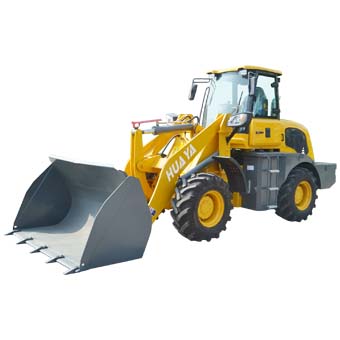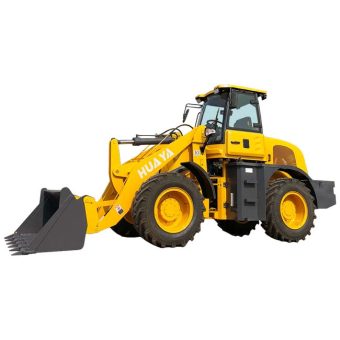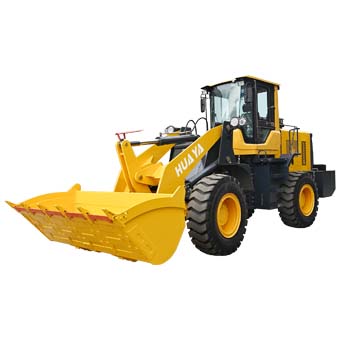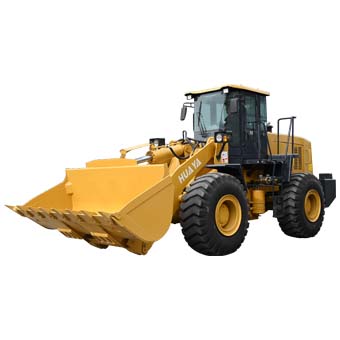
Nachrichten
Wenn man schwere Maschinen auf einer Baustelle sieht, ist es leicht, sie zu verwechseln. Viele Leute sehen einen Radlader und eine Planierraupe und fragen sich: Ist das dieselbe Maschine? Beide sind zwar leistungsstarke Erdbewegungsmaschinen, aber sie sind nicht identisch. Jede hat ihre eigene Konstruktion, ihre Stärken und ihre besten Einsatzmöglichkeiten.
Ein Radlader ist eine schwere Maschine, die zum Schaufeln, Heben und Transportieren von Materialien wie Erde, Sand, Kies oder Schutt konzipiert ist. Er ist mit einer großen, vorne montierten Schaufel ausgestattet, die an hydraulischen Armen befestigt ist. Im Gegensatz zu einer Planierraupe besteht seine Hauptaufgabe nicht im Schieben, sondern im Laden und Tragen.
Komponenten eines Radladers
Schaufel: Das wichtigste Werkzeug zum Schaufeln und Tragen.
Hydraulisches System: Steuert das Heben und Kippen der Schaufel.
Kabine: Sitz des Bedieners mit Bedienelementen und Sicht.
Vier große Räder: Ermöglichen Mobilität und Manövrierfähigkeit, insbesondere auf hartem oder halbweichem Boden.
Hauptfunktionen und Anwendungen
Radlader werden eingesetzt für:
Verschieben von gelagerten Materialien wie Kies oder Sand.
Beladen von Kippern oder Trichtern.
Beseitigung von Schutt nach Bau- oder Abbrucharbeiten.
Umschlag von landwirtschaftlichen Lasten wie Silage oder Dung.
Vorteile des Einsatzes von Radladern
Hohe Vielseitigkeit mit Anbaugeräten (z. B. Gabeln, Greifer, Pflüge).
Schnellere Mobilität auf gepflasterten oder halbgepflasterten Flächen im Vergleich zu Planierraupen.
Bessere Effizienz bei der Materialhandhabung, insbesondere beim Laden und Tragen.
Eine Planierraupe, oft auch als Dozer bezeichnet, ist eine schwere Maschine, die in erster Linie für den Abtransport großer Mengen von Erde, Felsen oder Schutt konzipiert ist. Sie verfügt über eine breite, flache Schaufel an der Vorderseite, die sich ideal zum Einebnen von Gelände, zum Roden von Land oder zum Anlegen von Straßenbetten eignet.
Hauptbestandteile einer Planierraupe
Klinge: Die breite Metallplatte an der Vorderseite zum Schieben.
Aufreißer: Zahnähnliche Werkzeuge am Heck zum Aufbrechen von hartem Boden.
Raupen: Raupenketten, die für Stabilität und Traktion auf unebenem oder weichem Gelände sorgen.
Fahrerkabine: Verstärkt für Sicherheit in rauen Umgebungen.
Hauptfunktionen und Anwendungen
Planierraupen werden hauptsächlich eingesetzt für:
Baufeldfreimachung und Standortvorbereitung.
Schieben und Verteilen großer Mengen Erde.
Nivellierungsflächen für den Bau.
Bergbau und Forstwirtschaft.
Vorteile des Einsatzes von Planierraupen
Unerreichte Schubkraft zum Bewegen von Erde und Felsen.
Stabilität auf unwegsamem Gelände dank der Raupen.
Langlebigkeit und Stärke für lange, schwere Einsätze.
Radlader vs. Planierraupe: Kernunterschiede
Konstruktionsunterschiede (Schaufel vs. Blatt)
Radlader: Hat eine Schaufel zum Schaufeln und Tragen.
Planierraupe: Verfügt über eine Schaufel zum Schieben und Planieren.
Vergleich von Leistung und Stromverbrauch
Planierraupen zeichnen sich durch ihre reine Schubkraft aus, während Radlader für das Heben und Transportieren optimiert sind.
Mobilität und Geländegängigkeit
Radlader: Schneller und manövrierfähiger auf festem Boden.
Planierraupen: Bessere Traktion und Stabilität auf weichem, schlammigem oder unebenem Gelände.
Kraftstoffeffizienz und Wartung
Radlader verbrauchen in der Regel weniger Kraftstoff für Transportaufgaben, während Planierraupen aufgrund der hohen Schubanforderungen mehr Kraftstoff verbrauchen.
Kann ein Radlader als Planierraupe verwendet werden?
Begrenzte planierraupenähnliche Fähigkeiten von Radladern
Mit den richtigen Anbaugeräten (z. B. einem Schiebeschild) kann ein Radlader einige Aufgaben übernehmen, die denen einer Planierraupe ähneln.
Warum die Substitution nicht immer funktioniert
Radlader sind jedoch nicht für ständiges Schieben ausgelegt. Die Belastung kann ihre Hydraulik und Reifen abnutzen.
Situationen, in denen ein Radlader eine Planierraupe ersetzen kann
Leichte Aufräumarbeiten vor Ort.
Kleinere Nivellierungsaufgaben.
Vorübergehende Erdbewegungsarbeiten, bei denen der Kauf oder die Anmietung einer Planierraupe nicht sinnvoll ist.
Anwendungsfälle in der Industrie: Welche Maschine eignet sich besser?
Anwendungen in der Bauindustrie
Radlader: Am besten geeignet für das Beladen von Lastwagen und den Umschlag von Zuschlagstoffen.
Planierraupen: Ideal für die Planierung und Vorbereitung von Grundstücken.
Bergbau und Steinbrüche
Radlader: Für den Transport von abgebautem Material.
Planierraupen: Zum Abtragen von Abraum und zum Einebnen von Flächen.
Land- und forstwirtschaftliche Nutzungen
Radlader: Nützlich für den Transport von Futtermitteln, Silage und Baumstämmen.
Planierraupen: Effektiv bei der Landrodung und beim Pflügen von neuem Terrain.
Straßenbau und Landerschließung
Radlader: Effizient im Materialumschlag.
Planierraupen: Unverzichtbar für die Planierung von Straßen und die Vorbereitung von Fundamenten.
Vergleich von Kosten, Effizienz und ROI
Vergleich der Anschaffungskosten
Planierraupen sind aufgrund ihrer Größe und robusten Bauweise oft teurer als Radlader.
Betriebskosten und Kraftstoffverbrauch
Radlader: Niedrigere Betriebskosten und bessere Kraftstoffeffizienz.
Planierraupen: Höherer Kraftstoffverbrauch durch das Schieben schwerer Lasten.
Langfristiger ROI von Radladern und Planierraupen
Der ROI hängt vom Einsatz ab. Bei schweren Rodungsarbeiten gewinnen Planierraupen. Für den täglichen Materialtransport sind Radlader rentabler.
Die Wahl zwischen einem Radlader und einer Planierraupe
Projektanforderungen und Geländetyp
Entscheiden Sie sich für eine Planierraupe für raue Geländeformen und für einen Lader für den Materialtransport.
Faktoren für Budget und Wartung
Wenn Sie kostenbewusst sind, ist ein Radlader vielleicht praktischer.
Bedienerfähigkeiten und Schulungserwägungen
Planierraupen erfordern eine speziellere Ausbildung, während Lader im Allgemeinen einfacher zu bedienen sind.
Ist ein Radlader also eine Planierraupe? Die einfache Antwort lautet nein. Sie sehen zwar ähnlich aus und können sich bei bestimmten Aufgaben überschneiden, aber sie sind für unterschiedliche Zwecke konzipiert. Radlader eignen sich hervorragend zum Heben, Laden und Tragen, während Planierraupen vor allem zum Schieben, Planieren und Nivellieren eingesetzt werden. Die Wahl der richtigen Maschine hängt von den speziellen Anforderungen Ihres Projekts, dem Gelände und dem Budget ab.
Nicht ganz. Er kann zwar leichte Schiebeaufgaben erledigen, aber er kann eine Planierraupe für schwere Planier- und Rodungsarbeiten nicht ersetzen.
Eine Planierraupe hat in der Regel mehr Schubkraft, während ein Radlader mehr Hebe- und Transportkapazität hat.
Ja, Radlader sind in der Regel in der Anschaffung und im Betrieb günstiger.
Ja, Anbaugeräte wie ein Schaufelblatt können den Funktionsumfang erweitern, aber die Leistung einer echten Planierraupe erreichen sie trotzdem nicht.
Eine Planierraupe eignet sich in der Regel besser für die Planierung und Vorbereitung des Straßenbelags, während Radlader für den Transport und die Verladung von Materialien unerlässlich sind.



